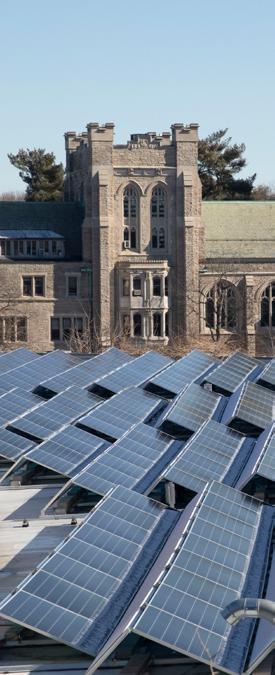
3 minute read
How we power
Harvard is accelerating a fossil fuel-free world

Advertisement
Harvard is focused on accelerating the adoption of clean energy and completely transitioning away from fossil fuels— creating a model for a healthier, decarbonized world.
Why Harvard Is Taking This On
Burning fossil fuels is the primary driver of climate change. The use of fossil fuels pollutes the air and water—damaging human health and disproportionately harming vulnerable communities.7 Focusing on addressing the wider harmful impacts of fossil fuels, rather than only greenhouse gas emissions, enables Harvard to drive progress across climate, equity, and health. This work, both on the supply and demand sides, will improve environmental quality and public health, and strengthen ecosystems on campus and in the local community. It will also improve the wellbeing of workers and communities along our value chain.
Key Priorities
Goal Zero: A fossil fuel-free Harvard
In 2018, Harvard set a goal to be fossil fuel-free by 2050. This goal is more ambitious than simply becoming “carbon neutral,” which means implementing o set projects like investing in new renewable energy and planting trees to absorb equivalent amounts of carbon emitted.
Goal Zero is focused on eliminating the use of fossil fuels—to the point where o sets are no longer needed. By recognizing the full set of damages caused by our use of fossil fuels, rather than only carbon emissions, Harvard is seeking to reduce the negative health impacts of fossil fuel use and production. We also aim to reduce plastics and toxic chemicals, which contain fossil fuels as main ingredients, as a part of our mission to decrease waste and create a healthier value chain.
Fossil Fuel-Free by 2050
OBJECTIVE: Harvard aims to reach Goal Zero by using fossil fuelfree power across campus operations in terms of both direct emissions (Scope 1)8 and indirect emissions (Scope 2)9, without using o sets.
– Eliminate onsite fossil fuel emissions from district energy systems
A key challenge Harvard faces in achieving Goal Zero is that the University owns and operates district energy systems that provide heating and cooling to support research and discovery in hundreds of buildings. These central systems currently run on fossil fuels and will need to be fossil fuel-free by 2050. These small power plants will require large capital investments, disruptive infrastructure improvements, and innovative technology to transition to fossil fuel-free energy sources, such as electri cation with 100% renewable electricity procurement, green hydrogen, or other future technology solutions. Ultimately a clean electricity grid is also essential.
OBJECTIVE: Eliminate onsite fossil fuel emissions from district energy systems.
– Procure 100% fossil fuel-free electricity
OBJECTIVE: Procure 100% of Harvard's electricity from fossil fuel-free energy sources connected to the New England electricity grid. As a bridging strategy to become fossil fuelfree, Harvard will contract for renewable energy projects to reduce carbon emissions and other air pollution, even if some projects are located outside New England, to become fossil fuel-neutral by
Harvard’s plan to address climate change
Harvard has developed a holistic plan that includes our fossil fuel-free goal (Scopes 1 and 2) and a focus on reducing value-chain emissions (Scope 3),10 encompassing the University’s direct and indirect emissions. Elements of this plan can be found throughout this document.
– Eliminate onsite fossil fuel emissions from stand-alone buildings
OBJECTIVE: Harvard has hundreds of stand-alone buildings that contain fossil fuel infrastructure, e.g., natural gas boilers, water heaters, and natural gas appliances in kitchens. The systems in these buildings will need to be electri ed and powered by zero-emissions electricity by 2050.

– Eliminate fossil fuel emissions from University vehicle eet
OBJECTIVE: Harvard will electrify its owned and operated vehicle eet and power these vehicles with zero-emissions electricity. See the “How we operate” section for more information.
– Reduce energy demand in buildings and district energy systems
OBJECTIVE: Harvard will continue to prioritize opportunities for energy e ciency and to reduce demand from district energy systems, purchased electricity, stand-alone buildings, and University vehicles. See the “How we build” and “How we operate” sections for more information.
Fossil Fuel-Neutral by 2026
OBJECTIVE:As a bridge to reach Goal Zero, Harvard has a shortterm objective to be fossil fuel-neutral by 2026. This means Harvard will zero out campus emissions (Scope 1 and Scope 2). It also means funding projects that zero out both greenhouse gas emissions and the health impacts from our use of fossil fuels, such as those caused by air pollution, to create positive bene ts for human health, social equity, and ecosystems.








